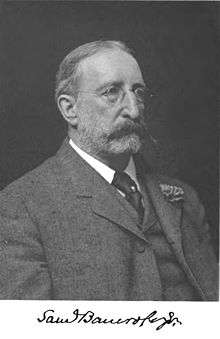Bancroft Mills
|
Bancroft and Sons Cotton Mills | |
|
Bancroft Mills in 2005 | |
| Location | Rockford Road, Wilmington, Delaware |
|---|---|
| Coordinates | 39°46′06″N 75°33′47″W / 39.7683°N 75.5631°WCoordinates: 39°46′06″N 75°33′47″W / 39.7683°N 75.5631°W |
| Built | 1787 |
| NRHP Reference # | 84000439 |
| Added to NRHP | 1984-12-20 |
Bancroft Mills was an abandoned mill complex along Brandywine Creek in Wilmington, Delaware, United States. It has been the site of some of the earliest and most famous mills near Wilmington and was the largest and longest running complex along the Brandywine.

Gilpin Mills was opened on the site in 1787 and was the first paper mill in Delaware. Bancroft Mills was opened in 1831 by Joseph Bancroft (1803–1874), an English immigrant who had worked in the Midlands textile industry. The mill was rebuilt following an 1839 flood and was expanded several times, including a large 1895 expansion. Separately Riddle Mills were built in 1845, on neighboring land and grew rapidly. The mills were consolidated in 1895 by the Bancroft family partnership, which was soon reformed into a corporation. In 1880, at half of its future size, Bancroft Mills was described as the largest cotton finishing mill in the United States, and in 1930 it was described as one of the largest cotton finishing works in the world.[1]

By the 1880s the firm was controlled by Samuel Bancroft who became the publisher of the Wilmington newspaper Every Evening and a major philanthropist. His collection of pre-Raphaelite paintings formed the basis of the Delaware Art Museum.[2]
His brother William Poole Bancroft donated nearby land to start Wilmington's extensive park system, and his donation for a public library is also considered the beginning of the Wilmington Public Library.[1]
While the Riddle Mills produced high-quality cloth, the Bancroft Mills were noted for their technological innovation and for finishing cloth that had been produced elsewhere. They were especially noted for producing fabric window shades. Bancroft introduced the mercerizing process into the United States, and pioneered the use of synthetic fabrics in weaving. They introduced the first permanent crease fabrics and Ban-Lon.[1]
As textile producers left the northeastern United States for the southern states, Bancroft Mills closed in 1961.
The complex was recently owned by Wilmington Piece Dye company which went bankrupt in May 2003. The site was then bought by O'Neill Properties Group, a company specializing in the renovation and revitalization of disused or potentially dangerous parcels of land. Bancroft Mills is scheduled to become a large luxury condominium complex, to be called Rockford Falls. Today the complex stands as a reminder of the significant milling history of the Brandywine Valley.
Around 1:30 a.m. May 2, 2015, a fire was reported at the site. Wilmington FD as well as Volunteer Fire Companies from New Castle County in Delaware as well as companies from Chester and Delaware Counties from Pennsylvania responded. The building was currently under demolition.
Early in the morning of November 9, 2016, fire engulfed a large section of the abandoned property, destroying several of the historic mill buildings. As of that day the cause had not yet been determined.[3]
See also
References
- 1 2 3 Alice Kent Schooler, 1984, NRHP Nomination Form – Bancroft & Sons Cotton Mills
- ↑ Dickason, David Howard (1953). The daring young men: the story of the American Pre-Raphaelites. Ayer Publishing. ISBN 0405084447, ISBN 978-0-405-08444-7. pp. 199–215
- ↑ Bretzger, William; Horn, Brittany (November 9, 2016). "Abandoned Bancroft Mills in Wilmington burns". The News Journal. Retrieved November 9, 2016.
External links
- NRHP Site Listing with Photo
- Joseph Bancroft & Sons from Delaware's Industrial Brandywine
- Joseph Bancroft & Sons Company records at Hagley Museum and Library
- Joseph Bancroft and Sons photograph collection at Hagley Museum and Library
- Joseph Bancroft & Sons Company, Miss America collection at Hagley Museum and Library. The collection documents the Joseph Bancroft & Sons Company's sponsorship of the Miss America Pageant.
- Miscellany Related to the Bancroft Mills at Hagley Museum and Library

